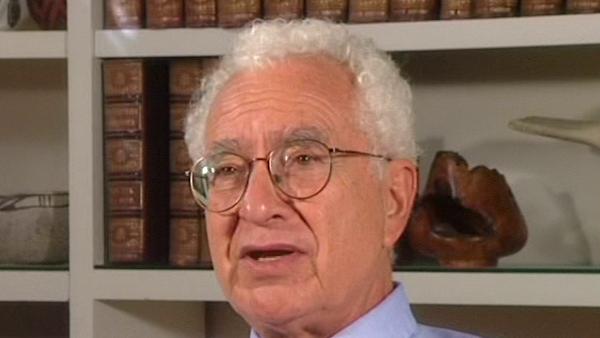NEXT STORY

A difference of opinions
RELATED STORIES

NEXT STORY

A difference of opinions
RELATED STORIES


|
Views | Duration | |
|---|---|---|---|
| 121. Meeting Millionshchikov | 789 | 03:49 | |
| 122. Millionshchikov's message to me | 648 | 02:46 | |
| 123. A meeting in Moscow | 694 | 01:08 | |
| 124. Talks about banning anti-ballistic missile systems | 625 | 01:20 | |
| 125. Pole dominance | 428 | 01:00 | |
| 126. Piecing together the particle physics puzzle | 471 | 00:53 | |
| 127. The Han-Nambu picture | 578 | 03:51 | |
| 128. A difference of opinions | 505 | 01:25 | |
| 129. Lecturing in Cambridge, England | 2981 | 02:14 | |
| 130. Bjorken's idea | 723 | 02:52 |


In 1966 there was a Festschrift volume prepared for my teacher, Viki Weisskopf, and as usual I... what's the word... procrastinated and didn't write my piece and didn't know what to write and didn't feel like writing and so on. And finally the volume appeared without anything from me, and I was so ashamed of not having contributed to this volume in honor of Viki that I didn't read it. But in it was an article by Yoichiro Nambu, or Nambu Yoichiro, a very good friend of mine whom I'd known for years and years. He was the... my first visitor to come to Caltech to see me when I first arrived at Caltech. And Yoichiro was pursuing some work that he had done with a man name Han–the Han-Nambu picture. And what they had done was to suggest that there were actually three quarks; three U quarks, three D quarks and three S quarks, and that the charges were not two-thirds minus a third and minus a third, but the integral charges, which when averaged over this new three-valued variable, would give two- thirds minus a third and minus a third. So from the point of view of later work what they were doing was introducing the color variable with a terrible mistake; namely that there was a color term in the electric current, in the charge operator or the electric current operator. Well, the first was correct, the second was wrong. He then suggested that these particles were real, that they could actually come out and be seen, but that they would be largely confined. They would be difficult to get out because there would be a potential between them, which would strongly favor the states that were actually seen.
By this time people had proposed a very crude SU(6) symmetry scheme which involved both the SU(3) variable and the spin, and this was quite useful for classification purposes. It gave rise to a fifty six representation which included the octet of spin one-half and the decimet of spin three-halves .
And let's see, what else? That's forty-eight- there must have been another octet and a… and a singlet. No, just another octet I guess. No, wait a minute, no that's right, no, no, no… no, no it's correct. No, fifty-six is just those two, just those two. It's an octet of spin a half which is sixteen, and eight times two and then a decimet of spin three-halves which is forty, and forty and sixteen is fifty-six. Sorry I got mixed up. Anyway, they would form a single multiplet under this combined spin and SU(3) group–SU(6). And that was what we needed because that was what we saw.
New York-born physicist Murray Gell-Mann (1929-2019) was known for his creation of the eightfold way, an ordering system for subatomic particles, comparable to the periodic table. His discovery of the omega-minus particle filled a gap in the system, brought the theory wide acceptance and led to Gell-Mann's winning the Nobel Prize in Physics in 1969.
Title: The Han-Nambu picture
Listeners: Geoffrey West
Geoffrey West is a Staff Member, Fellow, and Program Manager for High Energy Physics at Los Alamos National Laboratory. He is also a member of The Santa Fe Institute. He is a native of England and was educated at Cambridge University (B.A. 1961). He received his Ph.D. from Stanford University in 1966 followed by post-doctoral appointments at Cornell and Harvard Universities. He returned to Stanford as a faculty member in 1970. He left to build and lead the Theoretical High Energy Physics Group at Los Alamos. He has numerous scientific publications including the editing of three books. His primary interest has been in fundamental questions in Physics, especially those concerning the elementary particles and their interactions. His long-term fascination in general scaling phenomena grew out of his work on scaling in quantum chromodynamics and the unification of all forces of nature. In 1996 this evolved into the highly productive collaboration with James Brown and Brian Enquist on the origin of allometric scaling laws in biology and the development of realistic quantitative models that analyse the influence of size on the structural and functional design of organisms.
Tags: Caltech, Victor Weisskopf, Yoichiro Nambu, Moo-Young Han
Duration: 3 minutes, 52 seconds
Date story recorded: October 1997
Date story went live: 29 September 2010